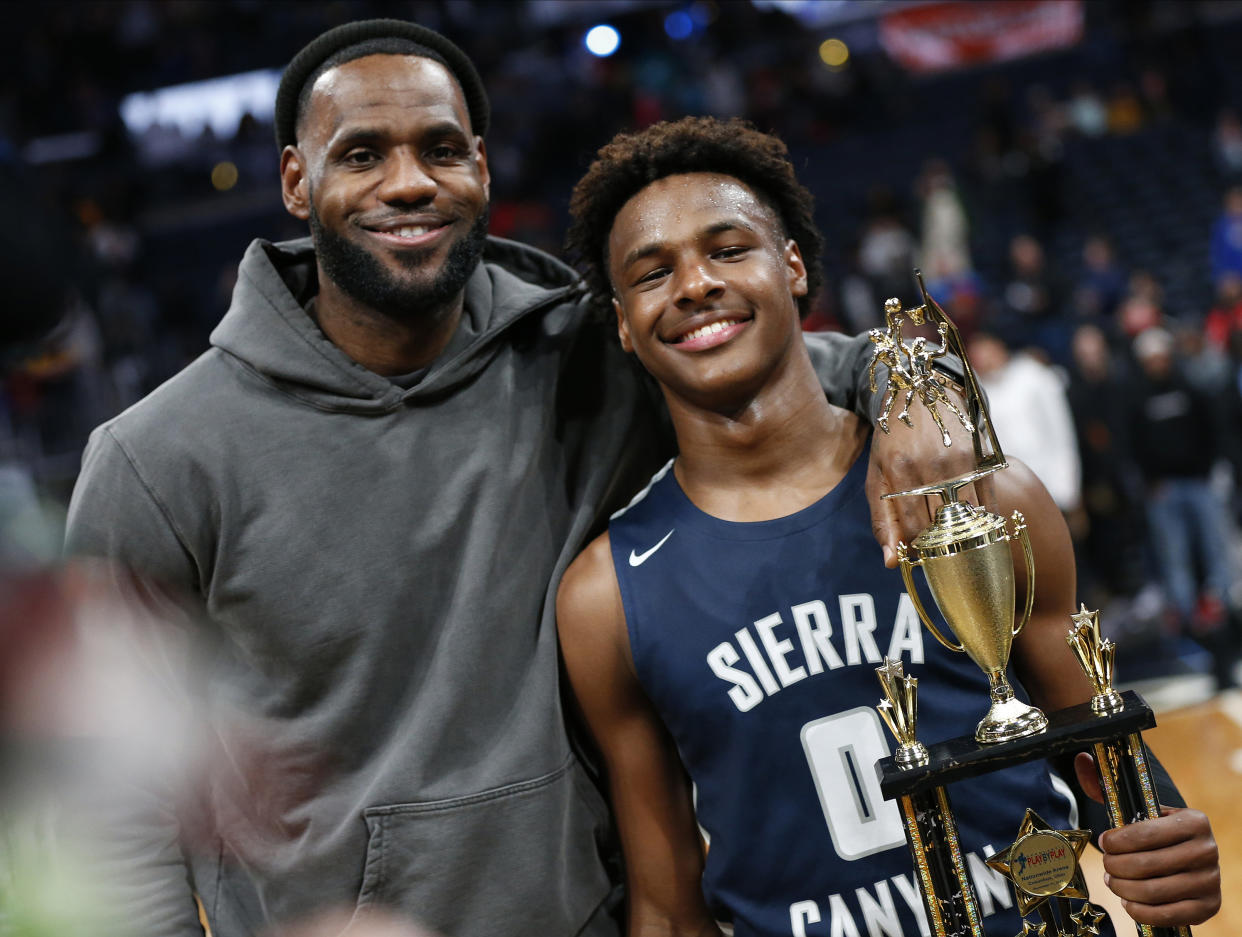#Will he play high-level basketball again? [Video]
![#Will he play high-level basketball again? [Video]](https://s.yimg.com/ny/api/res/1.2/NXbfqHMmebfHRIb4j06F4g--/YXBwaWQ9aGlnaGxhbmRlcjt3PTEyMDA7aD05MDU-/https://media.zenfs.com/en/aol_yahoo_sports_800/a4d2e958d5df66b384a2c490d06643c5)
Table of Contents
Photographers snapped pictures of Bronny entering a posh Santa Monica Italian restaurant with his family last Friday night. A day later, LeBron posted a video of Bronny smiling while playing a brief melody on a piano.
Those are “signs of the excellent quality of emergency care” that Bronny received when his heart malfunctioned and stopped beating, Indiana sports cardiologist Richard Kovacs told Yahoo Sports. The American College of Cardiology chief medical adviser credited the swift response by the USC athletics medical staff with helping Bronny avoid brain or organ damage from oxygen deprivation.
And yet Kovacs cautioned that Bronny’s speedy recovery offers “no reassurance” that he’ll ever play high-level basketball again. The underlying cause and severity of Bronny’s sudden cardiac arrest and his tolerance for risk will ultimately determine whether the McDonald’s All-American is able to continue his quest to join his illustrious father in the NBA.
“You have to approach these with caution and assess the chances of recurring cardiac arrest,” Kovacs said.
The cause of Bronny’s cardiac arrest is not yet publicly known. LeBron wrote last week that the family “will have more to say when we’re ready.” USC has consistently declined comment, citing “respect for student privacy.”
In an effort to better understand how likely Bronny is to play again and the factors influencing that decision, Yahoo Sports spoke with a handful of sports cardiologists who have diagnosed and advised athletes who have suffered sudden cardiac arrest. None has treated Bronny or has access to his medical records, but each spoke generally or shared their perspective based on the details that have been released publicly.
What do we know about Bronny’s cardiac arrest?
Minutes after Bronny’s cardiac arrest, a distraught witness attempted to convey the urgency of the situation to a 911 operator.
“We need to get an ambulance immediately,” the unidentified man said. “Listen, listen, listen, listen to me, OK? Get an ambulance here, now.”
That exchange is part of a heavily redacted recording of a 911 call released last Thursday under California public records law. The 59-second recording doesn’t identify Bronny by name, nor does it reveal anything about the 18-year-old’s medical condition.
Scanner traffic published last week by TMZ suggests that Bronny was unconscious at the time of the 911 call. A statement from Bronny’s cardiologist credited the “swift and effective response by USC athletics’ medical staff” for the highly touted basketball prospect arriving at Cedars-Sinai Medical Center “fully conscious, neurologically intact and stable.”
In similar situations, medical personnel on site have administered CPR to restore the flow of oxygen-rich blood to a cardiac arrest victim’s brain and organs before using an automatic external defibrillator to shock the heart back into rhythm. USC athletic trainers did exactly that to revive center Vince Iwuchukwu last summer when he collapsed and went into cardiac arrest during a workout.
“The single most important message from this event is that what saves lives is having access to an AED and a well thought-out emergency action plan,” said Benjamin Levine, a sports cardiologist at UT Southwestern Medical Center in Dallas. “That’s the way you protect athletes, coaches and spectators.”

How common is sudden cardiac arrest among elite athletes?
Sudden cardiac arrest is the No. 1 killer of young athletes, according to the American Heart Association. And Bronny “represents the single highest-risk demographic that we know of,” said Jonathan Drezner, director of the University of Washington’s center for sports cardiology.
There’s no ironclad explanation why late-adolescent male basketball players are the most at risk of suffering sudden cardiac arrest, but Drezner and his colleagues offer two educated guesses. Basketball requires sudden bursts of cardiovascular effort that may be more likely to reveal heart disorders. Also, the tall, long-limbed body type that is ideal for basketball seems to increase the likelihood of issues that can affect the heart.
What is the most common cause of sudden cardiac arrest among athletes?
Ask Levine this question, and the Dallas sports cardiologist’s response may come as a surprise.
“Sudden unexplained death,” said Levine, who consults with the NCAA, the NHL, the NFL and other athletic organizations. “That means that we have no idea what caused it.”
When doctors can determine the cause of sudden cardiac arrest among athletes, the most common diagnosis is a hereditary condition known as hypertrophic cardiomyopathy. It causes the heart muscle to thicken and stiffen abnormally, which can impede blood flow and lead to potentially lethal heart rhythms.
“People who have it are often asymptomatic for years,” said Lili A. Barouch, director of sports cardiology at Johns Hopkins University School of Medicine. “A person may go undiagnosed until a doctor notices the heart muscle has developed abnormally.”
Hypertrophic cardiomyopathy has without warning killed high schoolers, college standouts and NBA all-stars. It’s what cut down Loyola Marymount forward Hank Gathers on the precipice of the NBA and Boston Celtics guard Reggie Lewis on the cusp of superstardom.
For cardiologists, diagnosing hypertrophic cardiomyopathy in athletes is often tricky. Athletes’ hearts naturally grow bigger and stronger through years of intense exercise. As a result, there can be overlap between the appearance of an athlete’s heart and cases of hypertrophic cardiomyopathy.
“The key for Bronny’s future, in my opinion, is that they get the diagnosis right — and that’s not easy,” Kovacs said. “It takes a careful assessment by a team of cardiologists who are familiar with looking at diseased hearts and elite athlete hearts.”
What are other potential causes of sudden cardiac arrest?
Cardiologists often group the myriad of potential causes into three buckets: problems with the structure of the heart, problems with the heart’s electrical conduction system or problems that were acquired after birth.
Acquired problems include anything from a severe electrolyte abnormality, to the side effects of drugs or medication, to a rare condition known as myocarditis. Myocarditis is the inflammation of the heart muscle, usually following a viral infection.
Then there’s commotio cordis, the rare but often lethal heart disruption triggered by an often innocent-looking blow to the chest at just the wrong interval in the cardiac cycle. That’s what caused Buffalo Bills safety Damar Hamlin’s nationally televised cardiac arrest during a “Monday Night Football” game last January.
What’s the best-case scenario for Bronny’s basketball career?
“Something that’s treatable and reversible,” Levine said.
That means that doctors would first have to accurately pinpoint the underlying cause of Bronny’s cardiac arrest. Then that cause would need to be fixable via medicine.
“Certain patients with genetic disorders of the electrical system do extremely well taking simple medication,” Levine said. “Some kinds of electrical disorders are curable, but structural diseases of the heart tend to be less so.”
Commotio cordis would also be a favorable, if exceedingly unlikely, diagnosis for Bronny because it’s not a product of any structural or electrical heart abnormalities. As Kovacs put it, commotio cordis cannot reoccur without a second “1-in-a-million lightning strike blow to exactly the wrong spot in your chest at exactly the wrong time in the cardiac cycle.”
What’s the worst-case scenario for Bronny’s basketball career?
There’s a rare but diabolical structural abnormality known as arrhythmogenic right ventricular cardiomyopathy. Fatty tissue replaces normal heart muscle, weakening the heart over time and increasing the risk of life-threatening heart rhythms and heart failure.
Competitive sports are typically off limits for those diagnosed with ARVC. The more they exert themselves physically, the quicker the disease progresses and the heart muscle deteriorates.
“Every expert in the field would advise athletes with ARVC not to exercise,” Kovacs said. “It just trashes your heart and shortens your lifespan.”
How does an athlete at risk of sudden cardiac arrest decide whether to keep playing?
When an athlete with a newly diagnosed heart condition asks Levine for advice whether to retire from competitive sport or to risk playing on, the renowned cardiologist seeks to avoid dictating how much risk to assume.
He explains as candidly as possible what he knows and what he doesn’t about the potential for recurring sudden cardiac arrest. Then he compares that danger to climbing Mount Everest, boarding a space shuttle or another daring task that people choose to undertake despite the risk of death.
“I don’t think it’s reasonable for physicians to determine for the patient what an acceptable level of risk should be,” Levine said. “All we can do is do the best job we can to help patients assess the risk and make an informed decision.”
Levine’s approach reflects an industry-wide shift toward shared decision-making between a cardiologist and an athlete. The cardiologist examines, diagnoses and advises what courses of treatment are available, leaving the athlete to weigh the risks of playing against his or her own goals and aspirations.
In some cases, Barouch says, the discussion is “primarily between the doctor and the athlete.” In Bronny’s case, it may not be so simple. LeBron and Savannah James almost certainly will be involved. Same with USC coach Andy Enfield, team athletic trainers and lawyers responsible for determining how much liability risk the university can assume.
One year after suffering cardiac arrest during a game and collapsing face-first on the court, University of Florida men’s basketball star Keyontae Johnson decided that he wanted to try to resurrect his basketball career. Doctors at Florida weren’t comfortable medically clearing him to play, so Johnson sat out a second season before transferring to Kansas State and playing his way back onto the NBA’s radar.
“With college sports, there are lots of stakeholders that have an interest in the athlete playing but also not wanting to take on additional liability,” Barouch said. “It’s tough. It’s not always a straightforward decision.”
If you liked the article, do not forget to share it with your friends. Follow us on Google News too, click on the star and choose us from your favorites.
For forums sites go to Forum.BuradaBiliyorum.Com
If you want to read more News articles, you can visit our News category.




